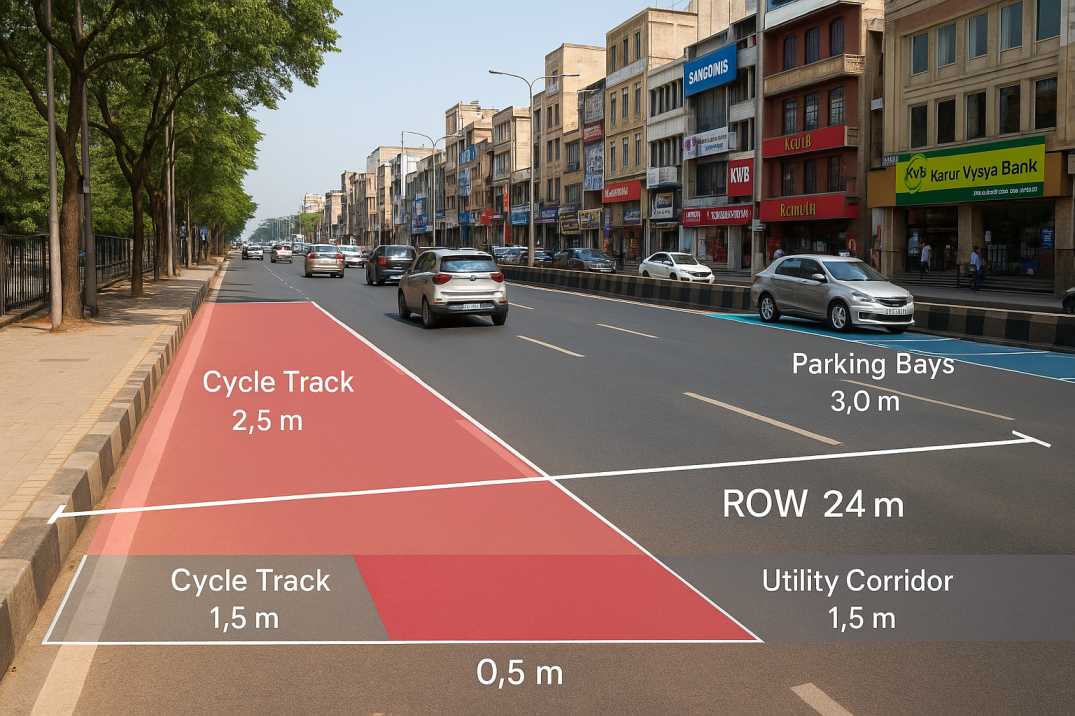Contact Us
RoadVision AI
Private Limited
Office No. 308 & 310, B Block
Ansal Chamber - 1, Bhikaji Cama Place,
Near Engineers India Limited (EIL) Bhawan, New Delhi - 110066
© 2024 | RoadVision AI | All rights reserved
When it comes to planning and developing urban roads in India, following IRC SP:50 guidelines is critical. Published by the Indian Roads Congress, IRC SP:50 serves as the national manual for urban roadway design, covering everything from urban road width standards to intersection planning and pavement engineering.
With the rise of AI road inspection and predictive analysis in infrastructure projects, understanding the core road design parameters outlined in IRC SP:50 is essential for engineers, planners, and contractors aiming to build smarter and safer roads.
This blog explores the top 10 design parameters from IRC SP:50 that every civil engineer and AI road asset management platform should know.

The Right of Way (ROW) is the total width of land acquired for the construction of the road, including the carriageway, footpaths, medians, and utilities. According to IRC SP:50, the minimum ROW for urban roads ranges from 12 meters to 60 meters depending on the hierarchy of the road—ranging from residential streets to arterial roads .
Why It Matters: It defines the extent of space available for infrastructure development, drainage, and pedestrian movement.
The carriageway width is the actual paved portion of the road used by vehicles. IRC SP:50 prescribes a standard lane width of 3.5 meters per lane, with flexibility based on traffic volume and road category.
AI-enabled systems like RoadVision's Pavement Condition Survey help validate carriageway conformity and optimize future widening using predictive analysis.
A proper urban road cross-section includes footpaths, cycle tracks, medians, parking bays, and drainage. IRC SP:50 specifies these dimensions based on land use and traffic characteristics. For example, footpaths should be at least 1.5 to 2.0 meters wide in residential zones.
Smart AI road inspection tools are now used to detect anomalies in cross-sections, ensuring compliance with these design standards.
The horizontal alignment refers to the plan view of the road's layout. IRC SP:50 emphasizes using gentle horizontal curves with proper transition lengths to improve safety and visibility, especially at intersections and bends.
Platforms like RoadVision AI leverage computer vision to automatically flag unsafe curve radii and deviations.
Vertical alignment defines how the road slopes along its length. IRC SP:50 recommends maximum gradients of:
Using AI in road asset management, engineers can now simulate traffic movement and water flow across gradients for long-term performance analysis.
Proper intersection design is vital for smooth traffic flow and pedestrian safety. IRC SP:50 specifies channelized intersections, roundabouts, and signalized junctions based on traffic density and road classification.
With RoadVision’s Traffic Survey tools, cities can now analyze real-time traffic behavior and optimize intersections for maximum efficiency.
Stopping sight distance (SSD) and overtaking sight distance (OSD) are critical for safety. IRC SP:50 defines these based on vehicle speed and gradient. Ensuring proper visibility at curves and intersections helps reduce road accidents.
Modern AI roadway inspection systems can now audit sightlines and vegetation encroachments automatically.
While IRC SP:50 focuses more on geometry, it also highlights the importance of pavement strength based on traffic loading and subgrade conditions. For detailed pavement design, IRC:37 is referenced, but initial layer thickness and material types are introduced here.
You can explore how RoadVision’s AI Pavement Condition Survey is used to automate pavement distress detection and crack progression forecasting using predictive analysis.
Urban roads must include dedicated pedestrian facilities, especially in commercial zones. IRC SP:50 mandates the provision of footpaths, zebra crossings, pedestrian signals, and guardrails based on traffic and land use.
Through RoadVision’s Road Inventory Inspection, missing or non-compliant pedestrian infrastructure is flagged automatically, improving audit efficiency.
IRC SP:50 includes recommendations for on-street and off-street parking spaces, as well as space for underground utilities like sewage, water, and telecom ducts. Proper utility planning prevents later disruptions and damage during maintenance.
AI-powered urban infrastructure management tools such as RoadVision’s Road Safety Audit ensure that parking bays, lighting, and drainage comply with IRC SP:50 guidelines.
With increasing urban traffic and infrastructure load, predictive analysis and AI road asset management have become essential tools in implementing IRC SP:50 standards. By integrating real-time data with AI models, road authorities can now:
RoadVision AI leads the shift to intelligent, data-driven road management, ensuring complete alignment with Indian Road Congress standards.
Adherence to IRC SP:50 guidelines is vital for building efficient, safe, and long-lasting urban roads in India. Understanding and implementing these road design parameters helps urban authorities and engineers align with national standards and improve road infrastructure sustainably.
RoadVision AI is revolutionizing road infrastructure development and maintenance by leveraging cutting-edge AI in road safety and computer vision technology. Through advanced digital twin technology, the platform performs comprehensive road safety audits, enabling early detection of potholes, cracks, and other surface issues, ensuring timely repairs and improved road conditions. It also enhances traffic surveys by providing data-driven insights to address challenges like traffic congestion and optimize road usage. With a focus on building smart roads, RoadVision AI ensures full compliance with IRC Codes, empowering engineers and stakeholders to reduce costs, minimize risks, and improve the overall road safety and transportation experience.
If you're ready to ensure your road projects are fully IRC SP:50 compliant, book a demo with us and see how RoadVision AI can help.
Q1. What is the minimum lane width in urban areas as per IRC SP:50?
According to IRC SP:50, the standard lane width in urban areas is 3.5 meters.
Q2. How does AI help in IRC SP:50 compliance?
AI tools enable automatic inspection, defect detection, and compliance validation for road elements like width, curves, and intersections.
Q3. What is the ideal ROW for arterial urban roads?
As per IRC SP:50, the ideal Right of Way (ROW) for arterial roads in urban areas is typically between 30 to 60 meters.